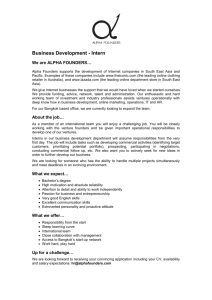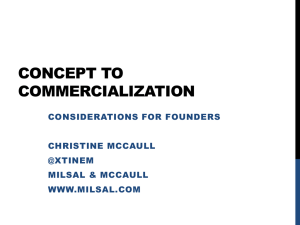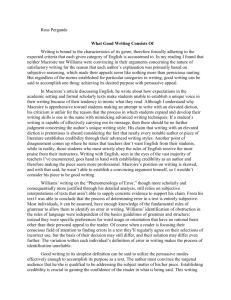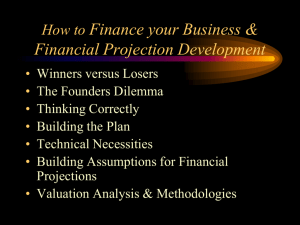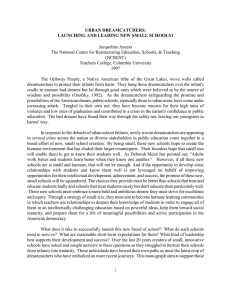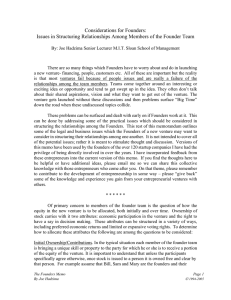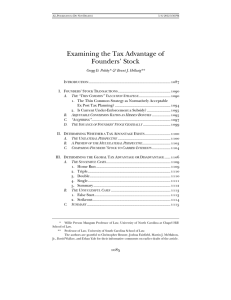Introductory Material, Executive Summary, and
advertisement
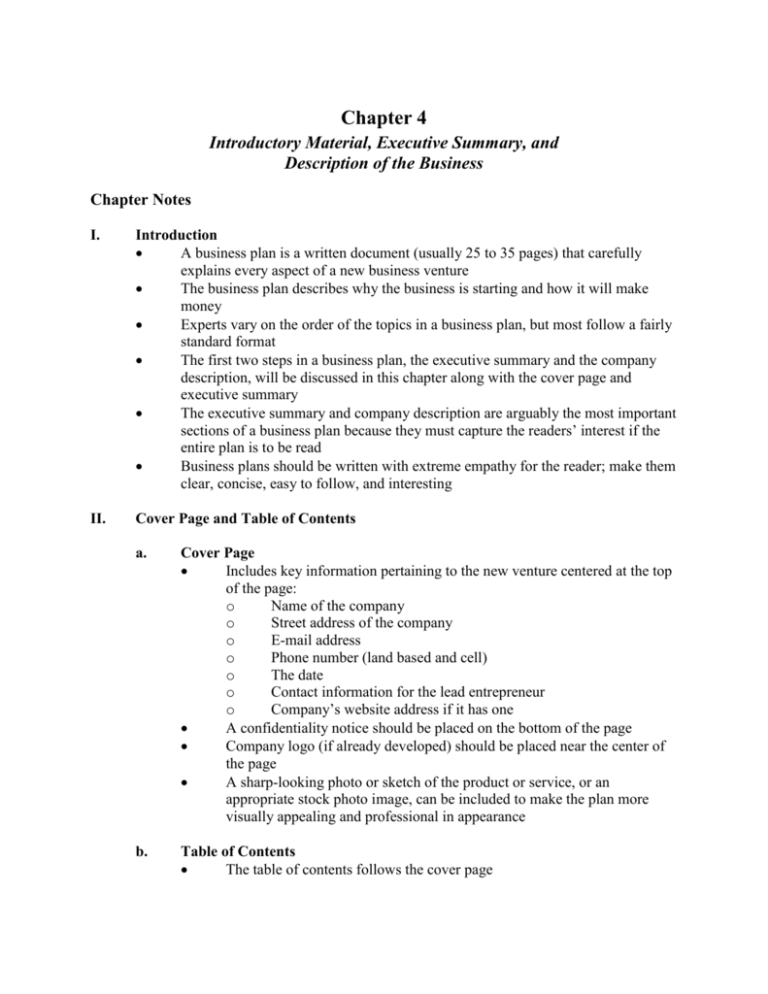
Chapter 4 Introductory Material, Executive Summary, and Description of the Business Chapter Notes I. Introduction A business plan is a written document (usually 25 to 35 pages) that carefully explains every aspect of a new business venture The business plan describes why the business is starting and how it will make money Experts vary on the order of the topics in a business plan, but most follow a fairly standard format The first two steps in a business plan, the executive summary and the company description, will be discussed in this chapter along with the cover page and executive summary The executive summary and company description are arguably the most important sections of a business plan because they must capture the readers’ interest if the entire plan is to be read Business plans should be written with extreme empathy for the reader; make them clear, concise, easy to follow, and interesting II. Cover Page and Table of Contents a. Cover Page Includes key information pertaining to the new venture centered at the top of the page: o Name of the company o Street address of the company o E-mail address o Phone number (land based and cell) o The date o Contact information for the lead entrepreneur o Company’s website address if it has one A confidentiality notice should be placed on the bottom of the page Company logo (if already developed) should be placed near the center of the page A sharp-looking photo or sketch of the product or service, or an appropriate stock photo image, can be included to make the plan more visually appealing and professional in appearance b. Table of Contents The table of contents follows the cover page II. III. The table of contents lists the main sections, subsections, and appendices to the plan along with the corresponding page numbers Executive Summary The executive summary is a short overview of the entire plan, and is the first item that appears in the business plan In many instances, an investor will first ask for an executive summary and will only request a full business plan if the executive summary is convincing Rather than serving as an introduction to the plan, the executive summary is intended to be a summary that provides readers with a good sense of the entirety of the plan itself a. Format The executive summary should not exceed two single-spaced pages The cleanest format follows the structure and order of the plan on a section-by-section basis There should be two versions of the executive summary: o One summary that is part of the business plan o One summary that is a standalone document for individuals who want to review an executive summary before deciding whether to request the full business plan Some investors ask for a short PowerPoint (10 to 15 slides) overview rather than a traditional executive summary Entrepreneurs should write the executive summary last to make sure it accurately reflects the entirety of the business plan b. Content Each section of the executive summary contains a synopsis of the same section in the broader business plan It’s important that the first section of the executive summary, covering the company description, begins by describing the opportunity and shows how the proposed business meets the opportunity Most experts recommend that the executive summary state the amount of funds being requested and the amount of equity the business is willing to surrender (in a section called “Status and Offering”) if the summary is being shown to investors Company Description The company description should start with a brief introduction that provides an overview of the company and reminds the reader of the reason it is starting There are two major points to be mindful of as you start writing this section: o A business plan is a story about an opportunity and how a business will take advantage of the opportunity o You must establish credibility by using facts and providing proof of research a. Company History This section should explain where the idea for the company came from If the company has been in existence for a while, provide a brief timeline in narrative form and talk about its major achievements You should also talk about the history of revenues, net income, and sales growth b. Mission Statement The mission statement defines why a company exists and what it aspires to become Written carefully, it can define the path a company takes and act as a financial and moral compass Articulate the mission or purpose of the company in as few words as possible Some companies also have mottos or taglines; these should be mentioned in this section of the plan There is no set procedure for how to come up with a mission statement or tagline; founders often get together and simply brainstorm ideas c. Products and Services The products and services section should explain your product or service, including a description of how it is unique and how you plan to position it in the marketplace Discuss how your company differs from others in terms of the products it offers, its location, and its price range Identify who your clientele will be and why they would patronize your business instead of others This is the ideal place to report results of your feasibility analysis Explain any proprietary aspects to your product or service or explain how you will create barriers to entry If you fail to candidly address difficult issues, such as creating barriers to entry, you will lose credibility d. Current Status e. V. This section reveals what major milestones in development your company has already reached Three issues are particularly important to address: o The current composition of your management team If you are an early-stage venture, you should mention future staffing plans o Early customer reaction to your product or service Summarize any results of feasibility analyses and indicate how close your product is to being market-ready o The financial status of your company How has the company been funded? Do you have any debt, or have you surrendered company equity? Clearly state how much funding you are seeking and for what purpose Legal Status and Ownership This section should indicate who owns the business and how ownership is split up Describe the founders’ agreement, outlining how ownership is to be shared among founders, if one has been established If you have multiple founders and no founders’ agreement, indicate that this step is pending to maintain credibility with your readers Indicate your current form of business ownership o You are a sole proprietorship or general partnership if you have not yet incorporated or created any other type of business entity o Better options for the long term include a subchapter S corporation, a C corporation, or a limited liability company (LLC) o You will need to retain an attorney to help you resolve this matter o If you have not determined the type of business ownership, indicate this step as pending so that you maintain credibility with your reader Selecting the Name for a Business Selecting the name for your business is not a part of the formal business planning process, but it’s an important activity A company’s name is normally the first thing that people associate with a business, and it can be an integral part of the company’s branding strategy The brand is a unique set of attributes that allow consumers to separate it from its competitors; you want a name that will facilitate rather than hinder the differentiation strategy a. b. Primary Consideration in Naming a Business The company name should compliment the type of business the company plans to be There are four categories to discuss when considering this issue: i. Customer-Driven Companies If a company plans to focus on a particular type of customer, its name should reflect the attributes of its clientele (e.g., Big and Tall Guys or ParentWatch) ii. Product- or Service-Driven Companies If a company focuses on a particular product or service, the name should reflect the advantages that its product or service provide (e.g., 1-800FLOWERS, XM Satellite Radio, Whole Foods Markets, and Jiffy Print) iii. Industry-Driven Companies If a company plans to focus on a broad range of products or services in a particular industry, its name should reflect the category it is participating in (e.g., General Motors, Linens N Things, Home Depot) iv. Personality- or Image-Driven Companies Some companies are founded by individuals who place an indelible stamp on the company. In this case, it may be smart to name the company after its founder (e.g., Liz Claiborne, Magic Johnson Enterprises) Legal Issues The general rule for business names is that they must be unique To determine whether a name is available in a particular state, the entrepreneur must contact the secretary of state’s office Instructions for how to go about obtaining a trademark on a name and a logo are available at the USPTO website The process for finding a name for a business can be frustrating because the most obvious names are often already taken A complicating factor is getting an Internet domain name that is the same as the company’s name A brief mention should be made in the business plan that a company’s name has been registered and trademarked, and that the Internet domain name has been secured If these activities have not been completed, mention this step as pending so that you maintain credibility with the reader
